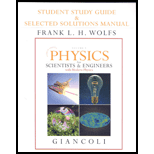
Concept explainers
(a)
Find the unknown nuclei in the given reaction.
(a)
Answer to Problem 1Q
The unknown nuclei in the given reaction is
Explanation of Solution
The given reaction is,
In the given reaction the reactants have 56 protons and 138 nucleons which means 82 neutrons. Thus the product must have 56 proton and 138 nucleons. Therefore the unknown product must have 56 proton and 82 neutron. Then the unknown product is
Conclusion:
Therefore, the unknown nuclei in the given reaction is
(b)
Find the unknown nuclei in the given reaction.
(b)
Answer to Problem 1Q
The unknown nuclei in the given reaction is
Explanation of Solution
The given reaction is,
In the given reaction the reactants have 56 protons and 138 nucleons which means 82 neutrons. Thus the product must have 56 proton and 138 nucleons. Therefore the unknown product must have 1 proton and 0 neutron. Then the unknown product is
Conclusion:
Therefore, the unknown nuclei in the given reaction is
(c)
Find the unknown nuclei in the given reaction.
(c)
Answer to Problem 1Q
The unknown nuclei in the given reaction is
Explanation of Solution
The given reaction is,
In the given reaction the reactants have 2 protons and 4 nucleons which means 2 neutrons. Thus the product must have 2 proton and 4 nucleons. Therefore the unknown product must have 0 proton and 0 neutron. Then the unknown product is
Conclusion:
Therefore, the unknown nuclei in the given reaction is
(d)
Find the unknown nuclei in the given reaction.
(d)
Answer to Problem 1Q
The unknown nuclei in the given reaction is
Explanation of Solution
The given reaction is,
In the given reaction the reactants have 81 protons and 201 nucleons which means 120 neutrons. Thus the product must have 81 proton and 201 nucleons. Therefore the unknown product must have 80 proton and 119 neutron. Then the unknown product is
Conclusion:
Therefore, the unknown nuclei in the given reaction is
Want to see more full solutions like this?
Chapter 42 Solutions
Physics for Science and Engineering With Modern Physics, VI - Student Study Guide
- Please see the attached image and answer the set of questions with proof.arrow_forwardHow, Please type the whole transcript correctly using comma and periods as needed. I have uploaded the picture of a video on YouTube. Thanks,arrow_forwardA spectra is a graph that has amplitude on the Y-axis and frequency on the X-axis. A harmonic spectra simply draws a vertical line at each frequency that a harmonic would be produced. The height of the line indicates the amplitude at which that harmonic would be produced. If the Fo of a sound is 125 Hz, please sketch a spectra (amplitude on the Y axis, frequency on the X axis) of the harmonic series up to the 4th harmonic. Include actual values on Y and X axis.arrow_forward
- Sketch a sign wave depicting 3 seconds of wave activity for a 5 Hz tone.arrow_forwardSketch a sine wave depicting 3 seconds of wave activity for a 5 Hz tone.arrow_forwardThe drawing shows two long, straight wires that are suspended from the ceiling. The mass per unit length of each wire is 0.050 kg/m. Each of the four strings suspending the wires has a length of 1.2 m. When the wires carry identical currents in opposite directions, the angle between the strings holding the two wires is 20°. (a) Draw the free-body diagram showing the forces that act on the right wire with respect to the x axis. Account for each of the strings separately. (b) What is the current in each wire? 1.2 m 20° I -20° 1.2 marrow_forward
- 2). How much energy is stored in the 50-μF capacitor when Va - V₁ = 22V? 25 µF b 25 µF 50 µFarrow_forward9). A series RC circuit has a time constant of 1.0 s. The battery has a voltage of 50 V and the maximum current just after closing the switch is 500 mA. The capacitor is initially uncharged. What is the charge on the capacitor 2.0 s after the switch is closed? R 50 V a. 0.43 C b. 0 66 C c. 0.86 C d. 0.99 C Carrow_forward1). Determine the equivalent capacitance of the combination shown when C = 12 pF. +11/20 2C C Carrow_forward
 Principles of Physics: A Calculus-Based TextPhysicsISBN:9781133104261Author:Raymond A. Serway, John W. JewettPublisher:Cengage Learning
Principles of Physics: A Calculus-Based TextPhysicsISBN:9781133104261Author:Raymond A. Serway, John W. JewettPublisher:Cengage Learning College PhysicsPhysicsISBN:9781938168000Author:Paul Peter Urone, Roger HinrichsPublisher:OpenStax College
College PhysicsPhysicsISBN:9781938168000Author:Paul Peter Urone, Roger HinrichsPublisher:OpenStax College Modern PhysicsPhysicsISBN:9781111794378Author:Raymond A. Serway, Clement J. Moses, Curt A. MoyerPublisher:Cengage Learning
Modern PhysicsPhysicsISBN:9781111794378Author:Raymond A. Serway, Clement J. Moses, Curt A. MoyerPublisher:Cengage Learning College PhysicsPhysicsISBN:9781305952300Author:Raymond A. Serway, Chris VuillePublisher:Cengage Learning
College PhysicsPhysicsISBN:9781305952300Author:Raymond A. Serway, Chris VuillePublisher:Cengage Learning College PhysicsPhysicsISBN:9781285737027Author:Raymond A. Serway, Chris VuillePublisher:Cengage Learning
College PhysicsPhysicsISBN:9781285737027Author:Raymond A. Serway, Chris VuillePublisher:Cengage Learning Physics for Scientists and Engineers with Modern ...PhysicsISBN:9781337553292Author:Raymond A. Serway, John W. JewettPublisher:Cengage Learning
Physics for Scientists and Engineers with Modern ...PhysicsISBN:9781337553292Author:Raymond A. Serway, John W. JewettPublisher:Cengage Learning





